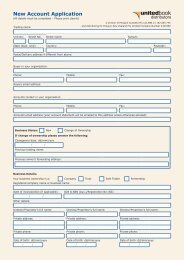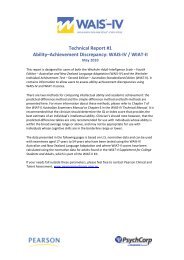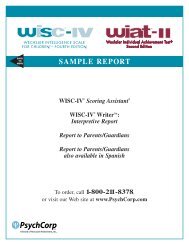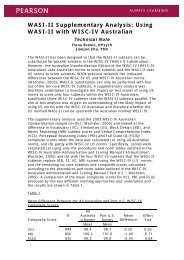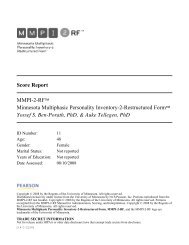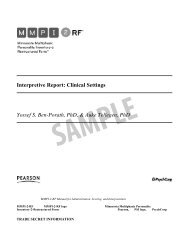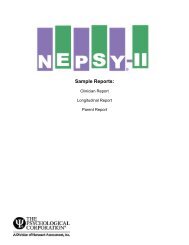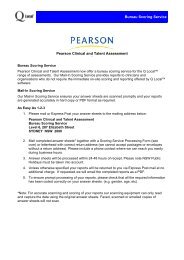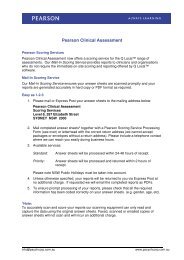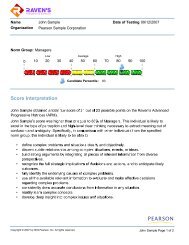WISC-IV with WIAT-II Writer Interpretive Sample Report - Pearson ...
WISC-IV with WIAT-II Writer Interpretive Sample Report - Pearson ...
WISC-IV with WIAT-II Writer Interpretive Sample Report - Pearson ...
Create successful ePaper yourself
Turn your PDF publications into a flip-book with our unique Google optimized e-Paper software.
BACK<br />
TO<br />
MENU<br />
Interpretation of <strong>WISC</strong>-<strong>IV</strong> Results<br />
<strong>WISC</strong>-<strong>IV</strong> and <strong>WIAT</strong>-<strong>II</strong> <strong>Interpretive</strong> <strong>Report</strong><br />
Haley's unique set of thinking and reasoning abilities make her overall intellectual functioning<br />
difficult to summarize by a single score on the Wechsler Intelligence Scale for Children – Fourth<br />
Edition (<strong>WISC</strong>-<strong>IV</strong>). Her verbal reasoning abilities are much better developed than her nonverbal<br />
reasoning abilities. Making sense of complex verbal information and using verbal abilities to<br />
solve novel problems are a strength for Haley. Processing complex visual information by<br />
forming spatial images of part-whole relationships and/or by manipulating the parts to solve<br />
novel problems <strong>with</strong>out using words is a less well-developed ability.<br />
Haley’s verbal reasoning abilities as measured by the Verbal Comprehension Index are in the<br />
High Average range and above those of approximately 79% of her peers (VCI = 112; 95%<br />
confidence interval = 105-118). The Verbal Comprehension Index is designed to measure verbal<br />
reasoning and concept formation. Haley performed comparably on the verbal subtests<br />
contributing to the VCI, suggesting that these verbal cognitive abilities are similarly developed.<br />
Haley’s nonverbal reasoning abilities as measured by the Perceptual Reasoning Index are in the<br />
Average range and above those of approximately 30% of her peers (PRI = 92; 95% confidence<br />
interval = 85-100). The Perceptual Reasoning Index is designed to measure fluid reasoning in<br />
the perceptual domain <strong>with</strong> tasks that assess nonverbal concept formation, visual perception and<br />
organization, simultaneous processing, visual-motor coordination, learning, and the ability to<br />
separate figure and ground in visual stimuli. Haley performed comparably on the perceptual<br />
reasoning subtests contributing to the PRI, suggesting that her visual-spatial reasoning and<br />
perceptual-organizational skills are similarly developed. Haley performed much better on<br />
abstract concept formation and categorical reasoning tasks that did not require verbal expression<br />
(Similarities = 12) than on abstract concept formation and categorical reasoning tasks that<br />
required verbal expression (Picture Concepts= 8).<br />
Haley's ability to sustain attention, concentrate, and exert mental control is in the Average range.<br />
She performed better than approximately 55% of her age-mates in this area (Working Memory<br />
Index = 102; 95% confidence interval 94-109).<br />
Haley's ability in processing simple or routine visual material <strong>with</strong>out making errors is in the<br />
Average range when compared to her peers. She performed better than approximately 27% of<br />
her peers on the processing speed tasks (Processing Speed Index = 91; 95% confidence interval<br />
83-101). Processing visual material quickly is an ability that Haley performs less well than her<br />
verbal reasoning ability. Processing speed is an indication of the rapidity <strong>with</strong> which Haley can<br />
mentally process simple or routine information <strong>with</strong>out making errors. Because learning often<br />
involves a combination of routine information processing (such as reading) and complex<br />
information processing (such as reasoning), a relative weakness in the speed of processing<br />
routine information may make the task of comprehending novel information more timeconsuming<br />
and difficult for Haley. Thus, this relative weakness in simple visual scanning and<br />
tracking may leave her less time and mental energy for the complex task of understanding new<br />
material. The noticed by Haley's referral source may be related to this weakness in processing<br />
speed. Although much less developed than her verbal and nonverbal reasoning abilities Haley's<br />
speed of information processing abilities are still <strong>with</strong>in the Average range and better than those<br />
Copyright © 2003 by Harcourt Assessment, Inc.<br />
All rights reserved. Printed in the United States of America.<br />
Page 2



